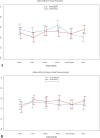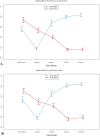Comparative analysis of continuous pericapsular nerve group block and supra-inguinal fascia iliaca compartment block for postoperative analgesia in total hip arthroplasty: a randomized controlled trial
- PMID: 40770360
- PMCID: PMC12326786
- DOI: 10.1186/s13018-025-06055-w
Comparative analysis of continuous pericapsular nerve group block and supra-inguinal fascia iliaca compartment block for postoperative analgesia in total hip arthroplasty: a randomized controlled trial
Abstract
Background: Effective postoperative pain management is essential for recovery after total hip arthroplasty. While opioids are commonly used, their adverse effects necessitate alternative strategies. Peripheral nerve blocks are increasingly utilized, including the pericapsular nerve group block and the supra-inguinal fascia iliaca compartment block. However, comparative data on their efficacy remain limited. This randomized controlled trial evaluated the analgesic effectiveness of these two techniques. The primary outcome was postoperative pain scores at rest and with movement. Secondary outcomes included opioid consumption, the need for rescue analgesia, and hemodynamic stability.
Methods: Sixty patients undergoing total hip arthroplasty under general anesthesia were randomly assigned to receive either a pericapsular nerve group block or a supra-inguinal fascia iliaca compartment block. Standardized ultrasound-guided techniques were used with equal volumes of local anesthetic. Pain scores were assessed postoperatively using the Visual Analog Scale. Opioid consumption and rescue analgesia use were recorded for twenty-four hours.
Results: At 12 and 24 h postoperatively, median VAS scores at rest and during movement were significantly lower in the PENG group (≤ 2.0) compared to the SIFICB group (> 4.0) (P < 0.001). Opioid consumption in the first 24 h was significantly lower in the PENG group (11.1 ± 1.5 mg morphine equivalents) than in the SIFICB group (18.4 ± 2.5 mg; P < 0.001). Hemodynamic parameters were stable, with no significant complications.
Conclusions: The pericapsular nerve group block provided superior analgesia and reduced opioid consumption compared to the supra-inguinal fascia iliaca compartment block. It should be considered a practical component of multimodal pain management for total hip arthroplasty.
Irb number: Ethics Committee of Tekirdağ Namık Kemal University (2023.06.01.06).
Clinical trial registration number: https://clinicaltrials.gov (NCT06806865).
Keywords: Acute pain; Pain management; Postoperative pain; Regional anesthesia; Total hip arthroplasty; Ultrasonography.
© 2025. The Author(s).
Conflict of interest statement
Declarations. Ethics approval and consent to participate: The study was approved by the Ethics Committee of Tekirdağ Namık Kemal University (Approval No: 2023.06.01.06, Date: 31.01.2023). Written informed consent was obtained from all participants. The trial was registered at ClinicalTrials.gov (NCT06806865). Consent for publication: Not applicable. Competing interests: The authors declare no competing interests.
Figures





References
-
- Abdelrahman TN, Abdelsattar MM, Abdelmoneim Fouly M, Bassiouny MA, Talaat SM. A comparative study between the impact of ultrasound guided pericapsular nerve group block (PENG) versus fascia Iliaca compartment block (FICB) on the quality of postoperative analgesia and ambulation in hip arthroplasty. Perioperative Care Operating Room Manage. 2025;38:100469.
-
- Ræder J. On behalf of the pwgotesora, pain T. SP53 PROSPECT guideline for pain management after hip fracture repair surgery: a systematic review and procedure-specific postoperative pain management recommendations. Reg Anesth Pain Med. 2022;47(Suppl 1):A62.
-
- Zheng J, Pan D, Zheng B, Ruan X. Preoperative pericapsular nerve group (PENG) block for total hip arthroplasty: a randomized, placebo-controlled trial. Reg Anesth Pain Med. 2022;47(3):155. - PubMed
-
- Rasappan K, Chua ITH, Tey JBL, Ho SWL. The continuous infusion fascia Iliaca compartment block: a safe and effective analgesic modality in geriatric hip fracture patients. Arch Orthop Trauma Surg. 2021;141(1):29–37. - PubMed
Publication types
MeSH terms
Substances
Associated data
LinkOut - more resources
Full Text Sources
Medical

